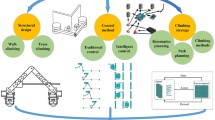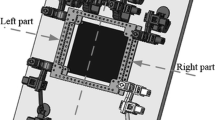Abstract
For complex climbing robots, which work in difficult 3D outdoor environments, the gravity force has an important influence with respect the robots changes during its motion. This type of climbing robots is self-supported in the complex 3D structures (bridges, skeleton of the buildings, etc.) which require periodic, manually performed inspections and maintenance. The use of non-conventional climbing robots for this type of operation is highly appropriate. Their locomotion system commonly comprises arms/legs that permit the robot’s 3D mobility (gait). These mechanisms also enable the robot to support itself and guarantee its stability. This paper presents the main features of non-conventional climbing robots’ mobility on complex 3D environments: power supply, number of DOFs, lightweight structure, gait, speed, secure grasp, etc. It also covers the general theory underlying the design of climbing robots, their kinematics, with its specific, unconventional mobility. The paper not only describes the climbing robot mobility theory but also provides several examples taken from the ROMA and MATS robots families. The developed robots have high degree of autonomy with totally on-board control system. These autonomous robots demonstrate in the course of real experimentation that the criteria for design, control strategy and path planning are accurate. Finally, the paper examines trends in climbing robot technology.
Similar content being viewed by others
References
Alexander, R., et al. 2003. A mobile climbing robot for high-precision manufacture and inspection of aero-structures. In 5th International Conference on Climbing and Walking Robots (CLAWAR’03), and Catania (Italy).
Balaguer, C., Gimenez, A., and Abderrahim. M. 2002. ROMA robots for inspection of steel based infrastructures. Industrial Robots, 29(3).
Balaguer, C., Gimenez, A., and Jardon, A. 2003a. MATS: An assistive robotic climbing system for personal care & service applications. 1st International Workshop on Advances in Service Robots (ASER’03) Bardolino (Italy).
Balaguer, C., Gimenez, A., and Jardon, A. 2003b. Light weight autonomous climbing robot for elderly and disabled persons’ services. In 4th International Conference on Field and Service Robots (FSR’03), Yamanaka Lake (Japan).
Balaguer, C., Gimenez, A., Pastor, J.M., Padrón, V.M., and Abderrahim, M. 2000. A climbing robot autonomous robot for inspection applications in 3D complex environments. Robotica, 18(3).
Balaguer, C., et al. 2002. A multi-purpose autonomous robot for traveling in metallic structures. Unmanned Vehicles for Aerial, Ground and Naval Military Operations. RTO/NATO, MP-052.
Cooke, D.S., Hewer, N.D., White, T.S., Galt, S., Luk, B.L., and Hammond, J. 1999. Implementation of modularity in Robug IV- Preliminary results. In 2nd International Conference on Climbing and Walking Robots (CLAWAR’99), Portsmouth (UK).
Gimenez, A. 2000. Metodología de diseño y control de robots escaladores. Aplicación a las tareas de inspección. PhD Thesis, Universidad Carlos III de Madrid.
Gimenez, A., Abderrahim, M., and Balaguer, C. 2001. Lessons from the ROMA I inspection robot development experience. In 3rd International Symposium on Climbing and Walking Robots (CLAWAR’01), Karlsruhe (Germany).
Gimenez, A., Balaguer, C., Sabatini, A., and Genovese, V. 2003. The MATS robotic system to assist disabled people in their home environment. In IEEE/RSJ International Conference on Intelligent Robots and Systems (IROS’03), Las Vegas (USA).
González de Santos, P. et al. 2000. A walking machine for industrial naval applications. IEEE Robotics and Automation Magazine.
Gradetsky, V. 2003. Wall climbing robot: Evolution to intelligent autonomous vehicles. In 1st International Conference on Climbing and Walking Robots (CLAWAR’98), Brussels (Belgium).
Hildebrand, M. 1995. Analysis of Vertebral Structure. John Wiley.
Kennedy, B., Aghazarian, H., Cheng, Y., Garrett, M., Hickey, G., Huntsberger, T., Magnom, L., Mahoney, C., Meyer, A., and Knight, J. 2001. Lemur: Legged excursion mechanical utility rover. Autonomous Robots, 11:201–205.
Luk, B.L., Collie, A.A., Bevan, N., and Billingsley, J. 1993. An articulated limb climbing vehicle with autonomous floor to wall transfer capability. In 1st IFAC Workshop on Intelligent Autonomous Vehicles, Hampshire (UK).
Nardelli, M., Jardon, A., Staroverov, P., Giménez, A., and Balaguer, C. 2003. System identification and control of the climbing robot ROMA II. In 5th International Conference on Climbing and Walking Robots (CLAWAR’03), Catania (Italy).
Padron, V.M., et al. 2000. Methodology to solve the RPP employing the isolated edge. In 11th Conference on Operational Research (OR 11), Cambridge (UK).
Schraft, R.D., et al. 2002. Mechanical design of an autonomous, lightweight robot for window cleaning. In 33rd International Symposium on Robotics (ISR’02), Stockholm (Sweden).
Author information
Authors and Affiliations
Corresponding author
Additional information
Carlos Balaguer received his Ph.D. in Automation from the Polytechnic University of Madrid (UPM), Spain in 1983. From 1983–1994 he was with the Department of Systems Engineering and Automation of the UPM as Associated Professor. Since 1994, he has been a Full Professor of the Robotics Lab at the University Carlos III of Madrid. Prof. Balaguer’s research has included robot design and development, robot control, path & task planning, force-torque control, assistive and service robots, climbing robots, legged and humanoid robots, and human-robot interaction. He has published more than 120 papers in journals and conference proceedings, and several books in the field of robotics. He is a member of IEEE and IFAC, and former President of IAARC.
Antonio Gimenez studied Electrical Engineering at the Polytechnic University of Madrid and received his PhD from the University Carlos III of Madrid in 2000. Currently he is Associated Professor at the Robotics Lab atthe University Carlos III of Madrid. He participated in numerous national and international R&D projects in robotics and automation. His research interest includes design and robot development, rehabilitation robots, climbing robots, and automation in construction. Recently he is very active in the field of computer-aided mechatronics design. He has published numerous refereed publications in international journals, and conference proceedings.
Alberto Jardón Huete is currently finishing his Ph.D. degree in Automation Engineering. He received his B.Sc. in electronics engineering (1998) and is graduated in Electrical Engineering (2002) at University Carlos III of Madrid. He is an active member of the Robotics Lab since 1997, and has collaborated in the development of the climbing robots ROMA I, ROMA II, and other research projects of relevance. Currently he is focused in the design and development of light weight service robots. His interests include assistive robotic design, mechatronics, robotic research, the development of tools to perform this research and the transfer of robotics technology to industry.
Rights and permissions
About this article
Cite this article
Balaguer, C., Gimenez, A. & Jardon, A. Climbing Robots’ Mobility for Inspection and Maintenance of 3D Complex Environments. Auton Robot 18, 157–169 (2005). https://doi.org/10.1007/s10514-005-0723-0
Issue Date:
DOI: https://doi.org/10.1007/s10514-005-0723-0




